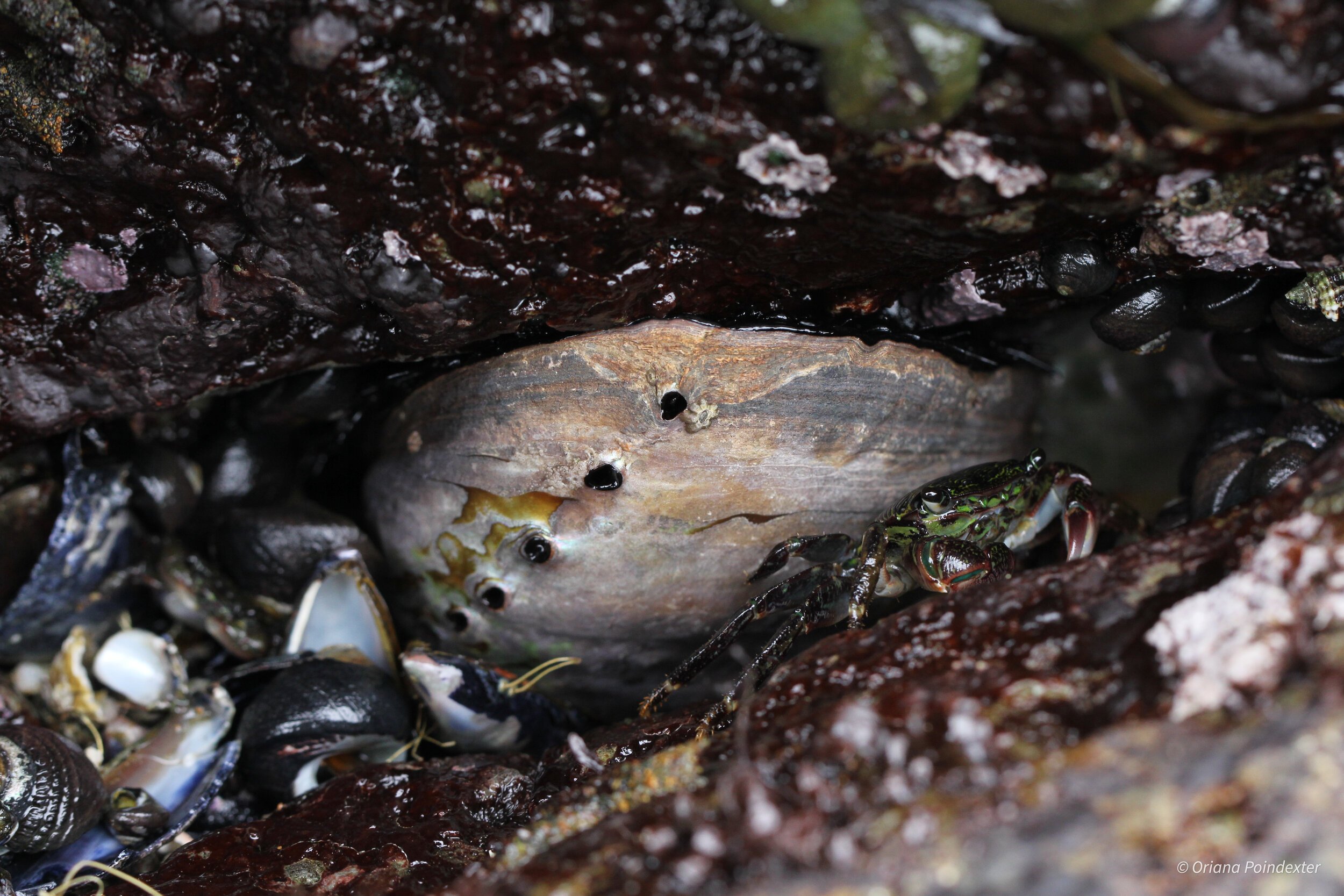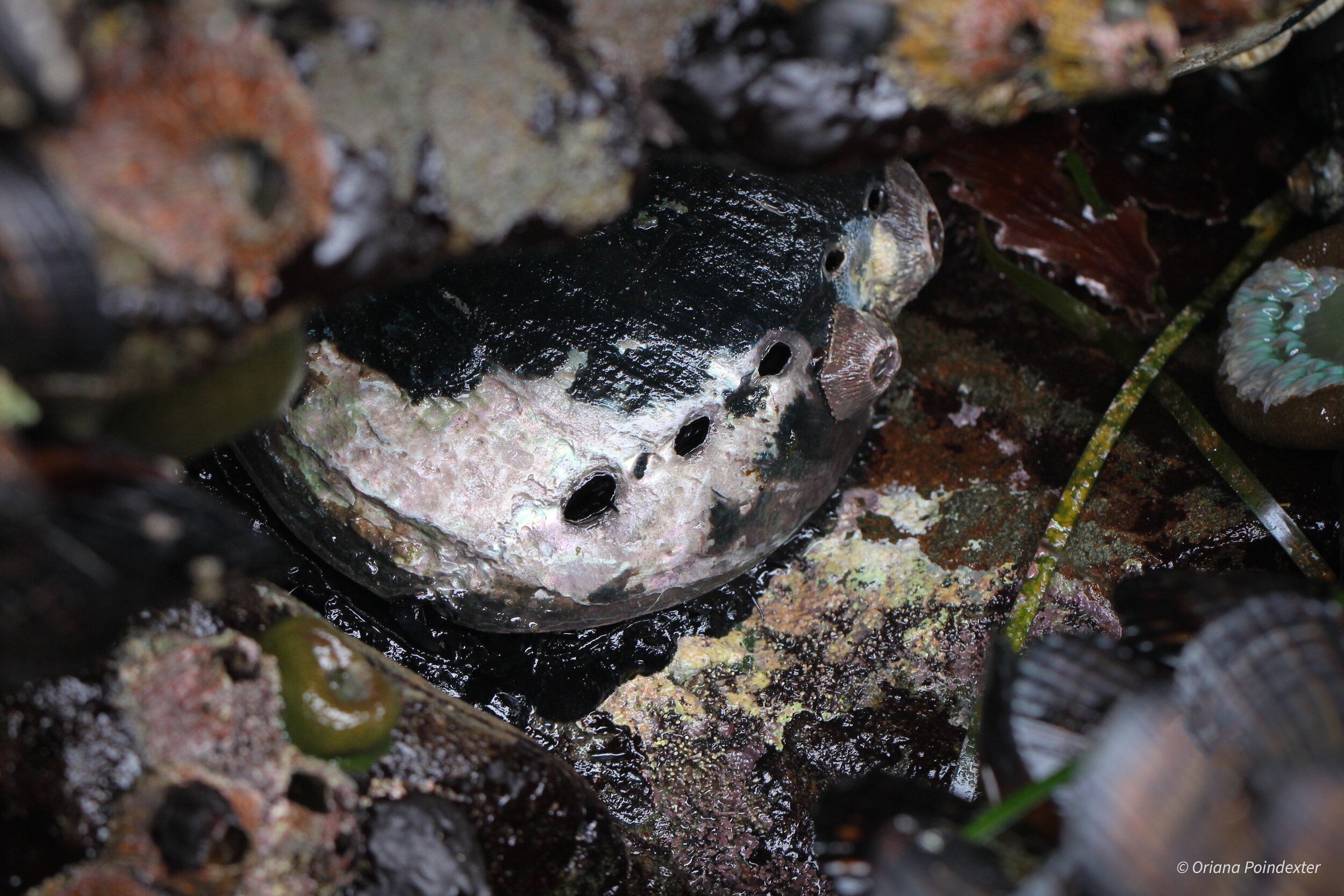Extreme Tidepooling for Black Abalone
Of California’s seven abalone species, the intertidal black abalone (Haliotis cracherodii) is relatively easy to access. But that doesn’t mean that finding and photographing them, in the era of COVID19, was easy.
The historic range of the species runs from Crescent City, CA through Cabo San Lucas, Baja California, including all the offshore islands. Today, that historic range has a gaping hole where San Diego, Orange, and Los Angeles Counties combine easy coastline access for millions of people with warmer water temperatures, making black abalone extremely scarce. Black abalone were listed as endangered in 2009, with withering syndrome cited as the primary threat to the recovery of the species.
I’ve never seen a black abalone, or found one of their shells, in my years of snorkeling, diving and tidepooling in those three counties. At one of my favorite dive spots in Baja California, I’ve found a couple black abalone shells and spotted a few solitary animals. And once, while camping on one of the Channel Islands, I snorkeled my way into a rocky cove that was stacked with black abalone everywhere I looked.
A black abalone shelters in a crevice at low tide, with a crab for company.
The abundance in that cove helped me picture the magnitude of California’s lost abalone populations. A century of shortsighted and mismanaged harvesting, combined with disease and ecosystem changes took populations from the millions to the endangered species list. Native coastal tribes harvested black abalone from the tidepools for thousands of years, leaving behind intricately crafted abalone regalia, and shells stacked high in middens. Successive waves of commercial and recreational harvesting of black abalone began in the 1860’s, continuing with varying intensity until the fishery was closed in 1993, once the combined effects of withering syndrome and overharvesting gave regulators no other option.
For this project, I wanted to photograph black abalone in their natural habitat. In a pre-COVID world, I could have driven across the border to that dive spot in Baja, or caught a ferry over to the Channel Island site where I knew I’d find plenty of animals. In our present state, however, I had to recalculate what was possible, and determined that my best option was to try to find black abalone along the mainland coast, where I could safely drive my own vehicle and remain socially distanced.
Black abalone territory: the isolated, rocky shorelines along California’s central coast.
My research pointed to the stretch of coast between Pacific Grove and the Monterey - San Luis Obispo County Line as the area where black abalone are “considered to be representative of healthy, natural populations”. To narrow things down, I contacted the Multi-Agency Rocky Intertidal Network (MARINe), a research group that runs long-term intertidal monitoring surveys from Alaska to Baja California, Mexico. They shared the locations for two of their monitoring sites, where they said I had a good chance to locate some black abalone.
Armed with a camera and the two site locations from MARINe, I set out to find some black abalone to illustrate this project. From my remote workplace/kitchen table in San Diego, CA, the directions they sent seemed easy enough to follow, but did include mentions of poison oak and barbed wire. On Google’s satellite maps, the areas looked promising - remote, rocky points of land with frothing whitewater and thick, dark kelp right offshore.
Black abalone are an intertidal species, meaning they live in the area of the shoreline that is underwater during high tides, but dry and exposed at low tides. Their tendency is to take shelter within the cracks and crevices of the rocks and boulders along the shore, away from the threats of hungry sea otter paws, human hands and the glaring sun. The tides deliver ample food to the abalone in the form of algae and drift kelp, but also pummels the animals with the full force of crashing waves.
A black abalone shell with a large hole in the center is evidence of the presence of sea otter predation in the area. Sea otters use rocks as tools to crush the shells of abalone in order to pry them off the rocks.
I’ve focused most of my photography for the past five years underwater. I am primarily a freediver, and underwater I mostly use a 35mm film camera with no light meter, which causes some people to say that I make images in the most difficult way possible. But underwater, there’s no gravity stopping you from floating into the perfect angle or perspective, and a quick grab onto the closest rock or kelp holdfast can keep you in position long enough to press the shutter.
In the intertidal zone, searching for black abalone requires extreme tidepooling, akin to a bizarre yoga routine. You’re constantly folded in half, squatting down and twisting your body around to peer into the deep crevices and under dark ledges, your eyes scanning for the telltale gleam of the apex of the abalone’s spiral shell, or the characteristic row of open respiratory pores. Once you find a black abalone, the next challenge is getting your camera to also see the abalone. Some people like to say that the abalone are where the light isn’t.
A black abalone in a crevice, with part of the jet-black epipodium visible below the lower edge of its shell.
Two black abalone shelter deep inside a crevice at low tide, surrounded by barnacles.
Photographing these shy crevice dwellers is technically challenging, as the cracks are narrower than a camera lens, and dark. I spent a weekend squatting over tidepools, kneeling on barnacles, elbowing mussels, and slipping on kelp, trying to line the barrel of the lens up with the abalone’s tiny homes. Masters of camouflage, the jet-black epipodium of the black abalone blends smoothly with the dark rock it holds on to, making it nearly impossible to see any of the animal itself underneath its shell. Interestingly, the animals that were most exposed to the light (and most ready to be photographed) had shells that seemed bleached or abraded by either the sun, the waves, or both, with the nacre shining through in some places.
On the mainland coast, black abalone appear to be forced ever deeper into the crevices, potentially by predation pressure from the recovered sea otter population, and the prying hands of human poachers. Sea otters leave evidence in the form of shells with holes from where they use rocks to bash through the abalone’s protective shield. The human poachers aim to leave no trace at all, but an encounter on the beach with a State Park ranger who searched my camera bag for abalone was evidence enough that poaching is an active issue in the area.
Back home, as I work my way through the photographs from the Central Coast, the tight framing of the crevices makes it hard to know which way is up. Rotating the images around and around on my screen, I try to make visual sense of the topsy-turvy intertidal world, where any surface could be the floor, or just as feasibly become the ceiling.
Overall, the mission felt successful, and even somewhat encouraging - for an endangered species, the black abalone seems to be holding on, at least along the isolated Central Coast. I found clusters of animals in a range of sizes, indicating that the abalone in these areas are reproducing successfully despite the shifting climate and the ever-present threats of disease, predation, and poaching.





